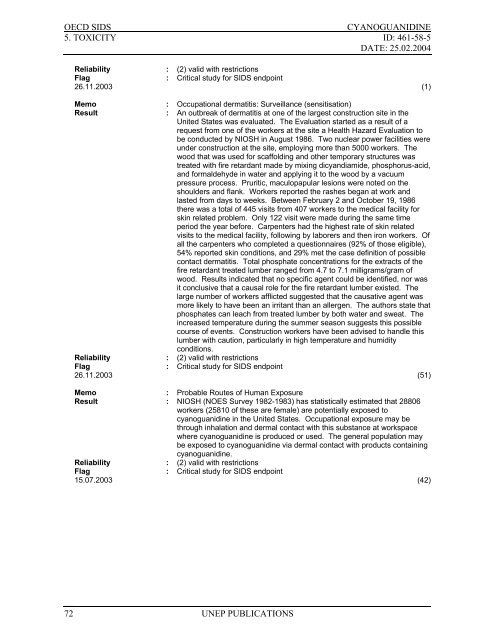Cyanoguanidine CAS N°: 461-58-5
Cyanoguanidine CAS N°: 461-58-5
Cyanoguanidine CAS N°: 461-58-5
Create successful ePaper yourself
Turn your PDF publications into a flip-book with our unique Google optimized e-Paper software.
OECD SIDS<br />
CYANOGUANIDINE<br />
5. TOXICITY ID: <strong>461</strong>-<strong>58</strong>-5<br />
DATE: 25.02.2004<br />
Reliability : (2) valid with restrictions<br />
Flag : Critical study for SIDS endpoint<br />
26.11.2003 (1)<br />
Memo : Occupational dermatitis: Surveillance (sensitisation)<br />
Result : An outbreak of dermatitis at one of the largest construction site in the<br />
United States was evaluated. The Evaluation started as a result of a<br />
request from one of the workers at the site a Health Hazard Evaluation to<br />
be conducted by NIOSH in August 1986. Two nuclear power facilities were<br />
under construction at the site, employing more than 5000 workers. The<br />
wood that was used for scaffolding and other temporary structures was<br />
treated with fire retardant made by mixing dicyandiamide, phosphorus-acid,<br />
and formaldehyde in water and applying it to the wood by a vacuum<br />
pressure process. Pruritic, maculopapular lesions were noted on the<br />
shoulders and flank. Workers reported the rashes began at work and<br />
lasted from days to weeks. Between February 2 and October 19, 1986<br />
there was a total of 445 visits from 407 workers to the medical facility for<br />
skin related problem. Only 122 visit were made during the same time<br />
period the year before. Carpenters had the highest rate of skin related<br />
visits to the medical facility, following by laborers and then iron workers. Of<br />
all the carpenters who completed a questionnaires (92% of those eligible),<br />
54% reported skin conditions, and 29% met the case definition of possible<br />
contact dermatitis. Total phosphate concentrations for the extracts of the<br />
fire retardant treated lumber ranged from 4.7 to 7.1 milligrams/gram of<br />
wood. Results indicated that no specific agent could be identified, nor was<br />
it conclusive that a causal role for the fire retardant lumber existed. The<br />
large number of workers afflicted suggested that the causative agent was<br />
more likely to have been an irritant than an allergen. The authors state that<br />
phosphates can leach from treated lumber by both water and sweat. The<br />
increased temperature during the summer season suggests this possible<br />
course of events. Construction workers have been advised to handle this<br />
lumber with caution, particularly in high temperature and humidity<br />
conditions.<br />
Reliability : (2) valid with restrictions<br />
Flag : Critical study for SIDS endpoint<br />
26.11.2003 (51)<br />
Memo : Probable Routes of Human Exposure<br />
Result : NIOSH (NOES Survey 1982-1983) has statistically estimated that 28806<br />
workers (2<strong>58</strong>10 of these are female) are potentially exposed to<br />
cyanoguanidine in the United States. Occupational exposure may be<br />
through inhalation and dermal contact with this substance at workspace<br />
where cyanoguanidine is produced or used. The general population may<br />
be exposed to cyanoguanidine via dermal contact with products containing<br />
cyanoguanidine.<br />
Reliability : (2) valid with restrictions<br />
Flag : Critical study for SIDS endpoint<br />
15.07.2003 (42)<br />
72<br />
UNEP PUBLICATIONS
















